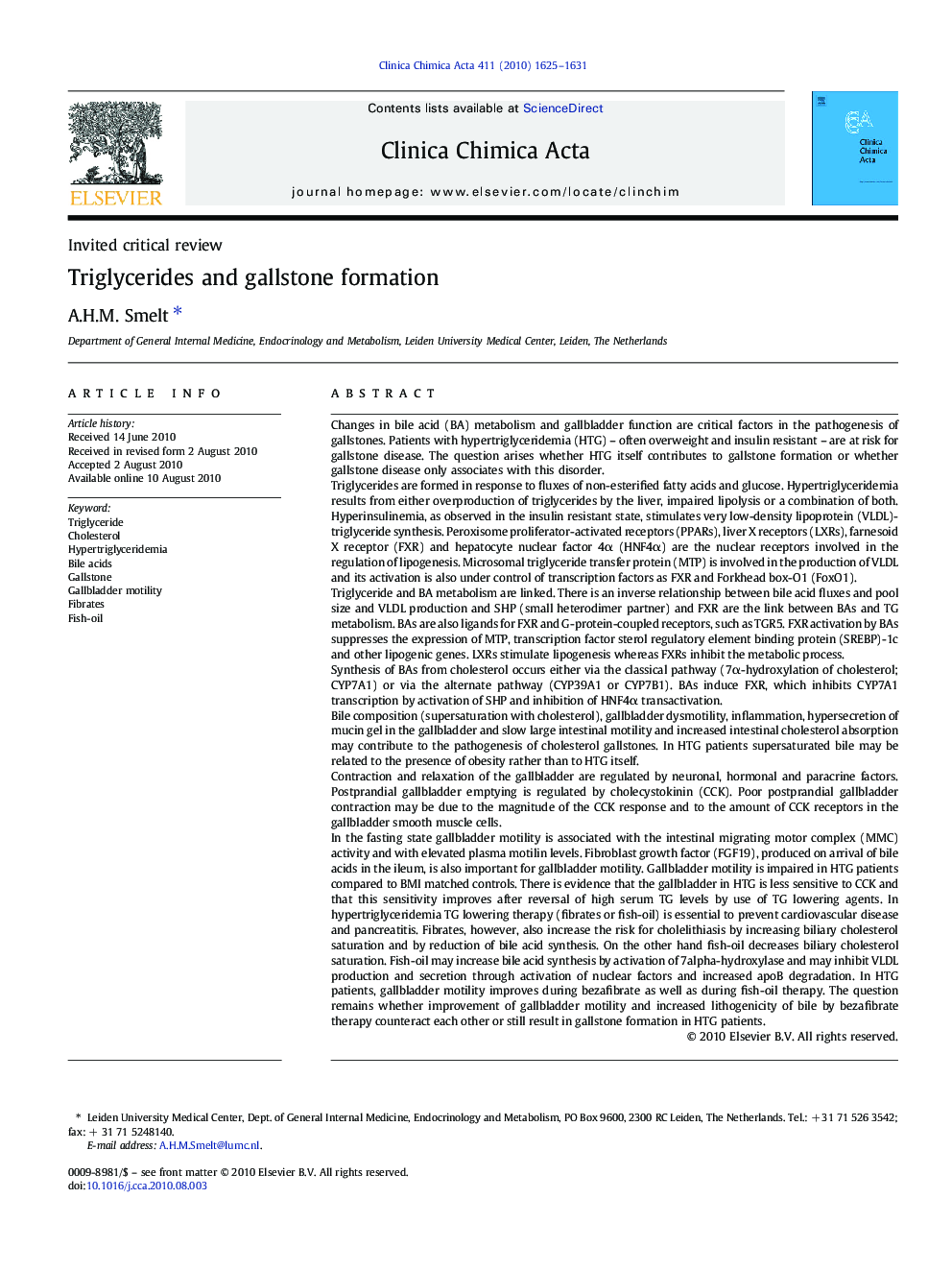| کد مقاله | کد نشریه | سال انتشار | مقاله انگلیسی | نسخه تمام متن |
|---|---|---|---|---|
| 1966717 | 1538710 | 2010 | 7 صفحه PDF | دانلود رایگان |

Changes in bile acid (BA) metabolism and gallbladder function are critical factors in the pathogenesis of gallstones. Patients with hypertriglyceridemia (HTG) – often overweight and insulin resistant – are at risk for gallstone disease. The question arises whether HTG itself contributes to gallstone formation or whether gallstone disease only associates with this disorder.Triglycerides are formed in response to fluxes of non-esterified fatty acids and glucose. Hypertriglyceridemia results from either overproduction of triglycerides by the liver, impaired lipolysis or a combination of both. Hyperinsulinemia, as observed in the insulin resistant state, stimulates very low-density lipoprotein (VLDL)-triglyceride synthesis. Peroxisome proliferator-activated receptors (PPARs), liver X receptors (LXRs), farnesoid X receptor (FXR) and hepatocyte nuclear factor 4α (HNF4α) are the nuclear receptors involved in the regulation of lipogenesis. Microsomal triglyceride transfer protein (MTP) is involved in the production of VLDL and its activation is also under control of transcription factors as FXR and Forkhead box-O1 (FoxO1).Triglyceride and BA metabolism are linked. There is an inverse relationship between bile acid fluxes and pool size and VLDL production and SHP (small heterodimer partner) and FXR are the link between BAs and TG metabolism. BAs are also ligands for FXR and G-protein-coupled receptors, such as TGR5. FXR activation by BAs suppresses the expression of MTP, transcription factor sterol regulatory element binding protein (SREBP)-1c and other lipogenic genes. LXRs stimulate lipogenesis whereas FXRs inhibit the metabolic process.Synthesis of BAs from cholesterol occurs either via the classical pathway (7α-hydroxylation of cholesterol; CYP7A1) or via the alternate pathway (CYP39A1 or CYP7B1). BAs induce FXR, which inhibits CYP7A1 transcription by activation of SHP and inhibition of HNF4α transactivation.Bile composition (supersaturation with cholesterol), gallbladder dysmotility, inflammation, hypersecretion of mucin gel in the gallbladder and slow large intestinal motility and increased intestinal cholesterol absorption may contribute to the pathogenesis of cholesterol gallstones. In HTG patients supersaturated bile may be related to the presence of obesity rather than to HTG itself.Contraction and relaxation of the gallbladder are regulated by neuronal, hormonal and paracrine factors. Postprandial gallbladder emptying is regulated by cholecystokinin (CCK). Poor postprandial gallbladder contraction may be due to the magnitude of the CCK response and to the amount of CCK receptors in the gallbladder smooth muscle cells.In the fasting state gallbladder motility is associated with the intestinal migrating motor complex (MMC) activity and with elevated plasma motilin levels. Fibroblast growth factor (FGF19), produced on arrival of bile acids in the ileum, is also important for gallbladder motility. Gallbladder motility is impaired in HTG patients compared to BMI matched controls. There is evidence that the gallbladder in HTG is less sensitive to CCK and that this sensitivity improves after reversal of high serum TG levels by use of TG lowering agents. In hypertriglyceridemia TG lowering therapy (fibrates or fish-oil) is essential to prevent cardiovascular disease and pancreatitis. Fibrates, however, also increase the risk for cholelithiasis by increasing biliary cholesterol saturation and by reduction of bile acid synthesis. On the other hand fish-oil decreases biliary cholesterol saturation. Fish-oil may increase bile acid synthesis by activation of 7alpha-hydroxylase and may inhibit VLDL production and secretion through activation of nuclear factors and increased apoB degradation. In HTG patients, gallbladder motility improves during bezafibrate as well as during fish-oil therapy. The question remains whether improvement of gallbladder motility and increased lithogenicity of bile by bezafibrate therapy counteract each other or still result in gallstone formation in HTG patients.
Journal: Clinica Chimica Acta - Volume 411, Issues 21–22, 11 November 2010, Pages 1625–1631